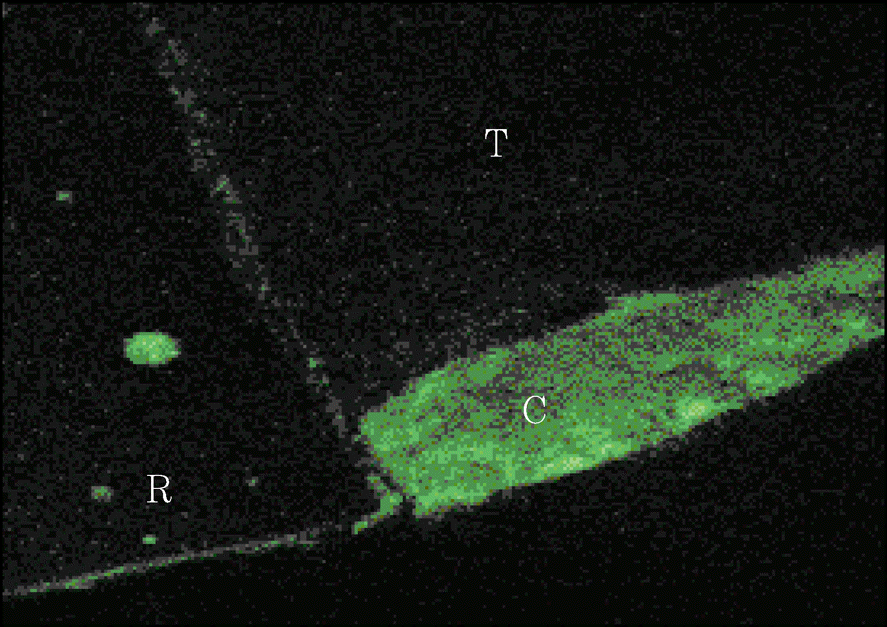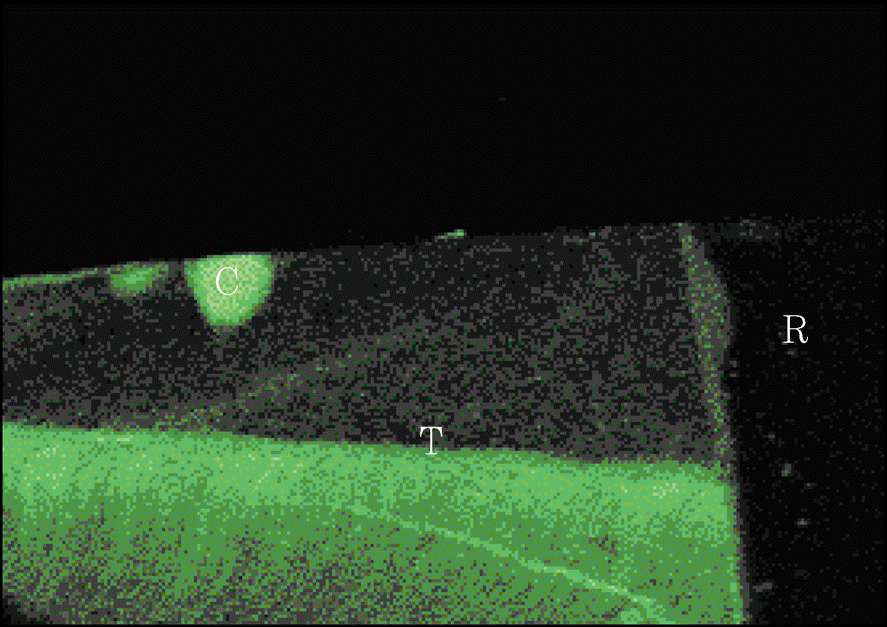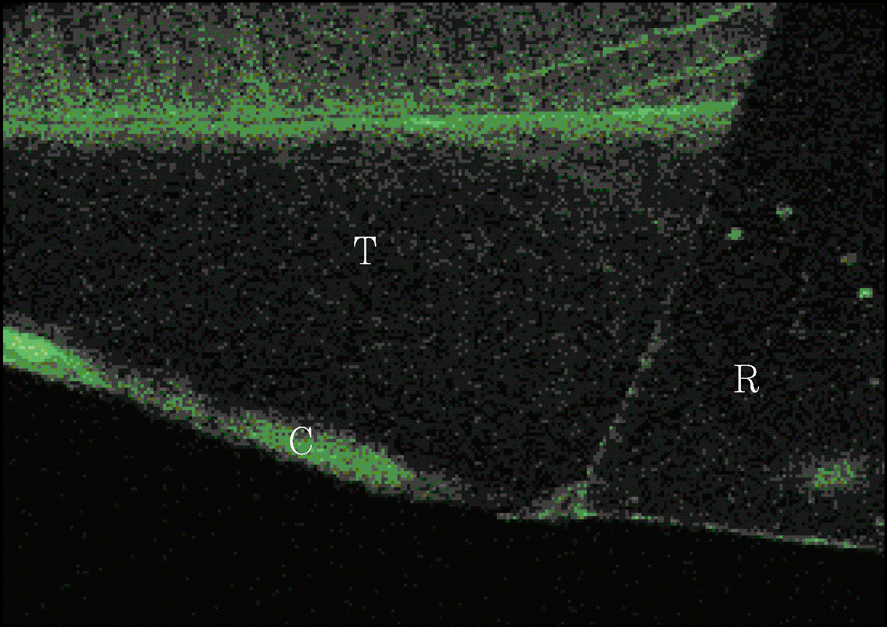ABSTRACT
The first purpose of present study was to compare the anticariogenic effect of compomer, resin modified glass ionomer cement and composite (RMGIC).
The second purpose was to evaluate the recently introduced methods, which use confocal scanning microscope, in detecting initial caries around restoration.
2×4×1.5mm cavities were prepared from the recently extracted 50 human teeth on the buccal or lingual surface. The prepared teeth were randomly devided into 5 groups and restored with each filling material. Group 1: Dyract AP, Group 2: compoglass F, Group 3: F2000, Group 4: Z100, Group 5:Fuji Ⅱ LC. The teeth were stored for 30 days in the distilled water, then stored in the buffer solution for artificial caries development; pH 4.3, lactic acid 100 mM, calcium 16 mM, phosphate 8mM, sodium azide 3mM. Then, the samples were sectioned longitudinally and examined with confical scanning microscope. The results showed that the use of compomer and resin modified glass ionomer cement showed caries inhibition zone whereas the composite did not. There was no difference in the width of caries inhibition zone between compomers and RMGIC. The confocal scanning microscope was useful in detecting initial caries around restoration.
Go to : 
References
1. Forsten L, Paunio IK.Fluoride release by silicate cements and composite resins. Scandinavian Journal of Dental Research. 80:515–519. 1972.

2. Wilson AD, Groffmann DM, Kuhn AT.The release of fluoride and other chemical species from a glass ionomer cement. Biomater. 6:431–433. 1985.
3. Forsten L.Fluoride release from a fluoride containing amalgam and luting cements. Journal of Dental Research. 84:348–350. 1976.
4. Rawls HR, Zimmerman BF.Fluoride-exchanging resins for caries prevention. Caries Research. 17:32–43. 1983.
5. Momoi Y, Kida K, Ikejima I, Yamamoto S, Murakami T, Kohno A.Compomer as a competitor to resin composite restorations. Modern trends in adhesive dentistry: Proceedings of the adhesive dentistry forum 99 in Tsurumi, Yokohama, Japan. 1st edition. Osaka, Japan: Kuraray Co. Ltd.;p. 2–19..
6. Qvist V, Lauberg L, Poulsen A, Teglers PT.Resin modified glass ionomers and compomer restorations in primary teeth. Three-year results (abstract). J Dent Res (Spec Iss). 77:637. 1998.
7. Folwaczny M, Loher C, Mehl A, Benz C, Hickel R.Class-V fillings with four different light curing materi-als:three year results (abstract). J Dent Res (Spec Iss). 77:190.
8. Folwaczny M, Mehl A, Kunzelmann KH, Hickel R.Clinical performance of a resin-modified glass-ionomer and compomer in restoring non-carious cervical lesions. 5-year results. Am J Dent. 14:153–156. 2001.
9. Park SH, Kim KY.The anticariogenic effect of fluoride in primer, bonding agent, and composite resin in the cavosurface enamel area. Oper Dent. 22:115–120. 1997.
10. Dionysopoulos P, Kotsanos N, Papadogiannis Y, Konstantinidis A.Artificial secondary caries around two new F-containing restoratives. Oper Dent. 23:81–86. 1998.
11. Millar BJ, Abiden F, Nicholson JW.In vitro caries inhibition by polyacid-modified composite resins. J Dent. 26:133–136. 1998.
12. Fontana M, Li Y, Dunipace AJ, Noblitt TW, Fischer GM, Katz BP, Stookey GK.Measurement of enamel demineralization using microradiography and confocal microscopy. Caries Res. 30:317–325. 1996.

13. Gonzalez-Cabezas C, Fontana M, Stookey GK. Detection of Mutans Streptococci in secondary carious lesions using immunofluorescent technique and confocal laser scanning microscopy. Caries Res. 29:198–203.
14. 차승우 윤태철, 박성호 이찬영금기연.공초점 레이저 주사 현 미경을 이용한 법랑질 초기 우식 재광화의 정량적 분석. 대한치 과보존학회지. 26:1–8. 2001.
15. 박성호 이찬영이정석.유산완충용액을 이용한 인공치아우식 의 형성에 미치는 산의 농도와 pH 에 관한 연구. 대한치과보존 학회지. 18:277–290. 1993.
Go to : 
 | Fig. 1.Confocal image (X100) of tooth which was restored with Z100 and stored in demineralizing solution. The artificial caries extends to the restoration. R: Restoration, C: Caries, T: Tooth |
 | Fig. 2.Confocal image (X100) of tooth which was restored with Fuji Ⅱ LC or Compomers. and stored in demineralizing solution. The artificial caries extends short of restoration. R: Restoration, C: Caries, T: Tooth |
 | Fig. 3.Confocal image (X100) of tooth which was restored with Fuji Ⅱ LC or Compomers. and stored in demineralizing solution. The artificial caries extends short of restoration R: Restoration, C: Caries, T: Tooth |




 PDF
PDF ePub
ePub Citation
Citation Print
Print


 XML Download
XML Download